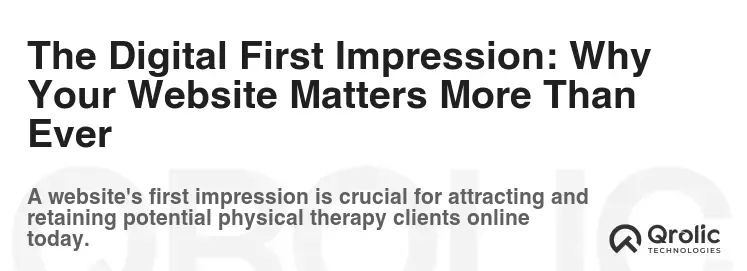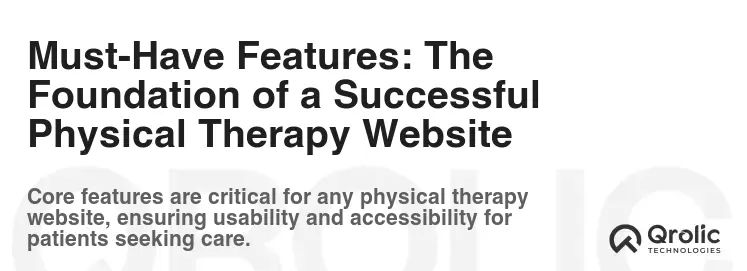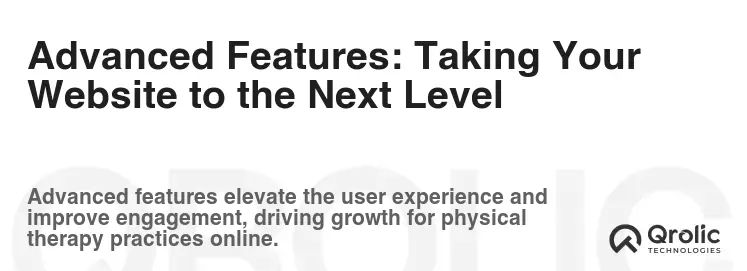Quick Summary:
- Your website is your crucial virtual clinic storefront.
- Offer easy online booking and clear service details.
- Provide helpful patient resources and trusted testimonials.
- Regular updates and security keep your site effective.
Table of Contents
- The Digital First Impression: Why Your Website Matters More Than Ever
- Beyond the Brochure: Website Functionality Drives Patient Acquisition and Retention
- Must-Have Features: The Foundation of a Successful Physical Therapy Website
- 1. Clear and Compelling Value Proposition: Show Patients What You Offer
- 2. User-Friendly Navigation: Guide Patients Effortlessly
- 3. Optimized Appointment Scheduling: Make Booking Easy
- 4. Comprehensive Service Pages: Showcase Your Expertise
- 5. Compelling “About Us” Page: Build Trust and Connection
- 6. High-Quality Patient Resources: Provide Value Beyond Treatment
- 7. Clear Contact Information and Location Details: Make it Easy to Connect
- 8. Testimonials and Reviews: Leverage Social Proof
- 9. Blog: Share Your Knowledge and Expertise
- 10. Mobile-Responsive Design: Reach Patients on Any Device
- Advanced Features: Taking Your Website to the Next Level
- 1. HIPAA Compliance: Protect Patient Privacy
- 2. Video Integration: Engage and Educate Patients
- 3. Interactive Tools and Assessments: Enhance Engagement
- 4. Personalized Content: Tailor the Experience
- 5. Multilingual Support: Reach a Wider Audience
- Website Maintenance: Keeping Your Digital Presence Healthy
- 1. Regular Content Updates: Keep Information Fresh
- 2. Security Updates: Protect Against Threats
- 3. SEO Monitoring and Optimization: Stay Visible
- 4. Performance Monitoring: Ensure Speed and Reliability
- Qrolic Technologies: Your Partner in Digital Success
- How Qrolic Technologies Can Help Your Clinic Thrive:
- The Takeaway: A Great Website is an Investment in Your Practice
The Digital First Impression: Why Your Website Matters More Than Ever

In today’s digital age, your website is often the first interaction a potential patient has with your physical therapy clinic. Think of it as your virtual storefront. Is it welcoming? Informative? Easy to navigate? A poorly designed website can send potential patients running to the competition faster than you can say “rotator cuff tear.” A stellar website, on the other hand, builds trust, attracts new patients, and streamlines your practice’s operations. This isn’t just about having an online presence; it’s about having a compelling and functional one.
Beyond the Brochure: Website Functionality Drives Patient Acquisition and Retention
Gone are the days of static, brochure-style websites. Today’s patients expect a dynamic, interactive experience. They want to find information quickly, book appointments easily, and access helpful resources without picking up the phone. Your website needs to be more than just a pretty face; it needs to be a powerful tool that helps you attract new patients, nurture existing relationships, and manage your practice efficiently.
Must-Have Features: The Foundation of a Successful Physical Therapy Website

These are the core elements that every physical therapy clinic website must have to provide a positive user experience and achieve its goals.
1. Clear and Compelling Value Proposition: Show Patients What You Offer
- What: Your value proposition is a concise statement that clearly communicates the unique benefits of choosing your clinic. What problems do you solve? What makes you different from other physical therapists?
- Why: In a sea of competitors, your value proposition is what grabs a potential patient’s attention and convinces them to explore further. It speaks directly to their needs and desires.
-
How:
-
Identify Your Target Audience: Who are you trying to reach? (e.g., athletes recovering from sports injuries, seniors seeking pain relief, individuals recovering from surgery).
-
Highlight Your Unique Selling Points: What makes you different? (e.g., specialized techniques, experienced therapists, personalized treatment plans, a state-of-the-art facility).
-
Focus on Benefits, Not Just Features: Instead of saying “We offer manual therapy,” say “We use hands-on techniques to relieve pain and restore mobility.”
-
Keep it Concise and Memorable: Aim for a short, impactful statement that sticks in the patient’s mind.
-
Example: “Restore your movement, reclaim your life. Personalized physical therapy plans tailored to your unique needs.”
-
2. User-Friendly Navigation: Guide Patients Effortlessly
- What: Intuitive navigation allows visitors to easily find the information they’re looking for, without frustration or confusion.
- Why: Poor navigation is a surefire way to lose potential patients. If they can’t find what they need, they’ll simply go elsewhere.
-
How:
- Simple Menu Structure: Use clear, concise labels for your main menu items (e.g., “About Us,” “Services,” “Appointments,” “Contact”).
- Logical Organization: Group related content together under appropriate headings.
- Search Functionality: Implement a search bar to allow users to quickly find specific information.
- Breadcrumb Navigation: Show users their current location within the website structure.
- Mobile-Friendly Design: Ensure your navigation is easy to use on smartphones and tablets.
- Key Navigation Pages:
- Homepage: A clear overview of your practice, services, and value proposition.
- About Us: Information about your therapists, their qualifications, and your clinic’s philosophy.
- Services: Detailed descriptions of the services you offer (e.g., sports physical therapy, geriatric physical therapy, post-surgical rehabilitation).
- Conditions Treated: A list of conditions you treat (e.g., back pain, neck pain, knee pain, shoulder pain).
- Appointments: Information on how to schedule an appointment (online booking, phone number, contact form).
- Contact Us: Your clinic’s address, phone number, email address, and a contact form.
- Patient Resources: Helpful information for patients (e.g., FAQs, forms, exercise videos, articles).
- Blog: Share informative articles and tips related to physical therapy.
3. Optimized Appointment Scheduling: Make Booking Easy
- What: Seamless online appointment scheduling allows patients to book appointments 24/7, without having to call your office.
- Why: Online scheduling is a major convenience factor for patients. It saves them time and eliminates phone tag. It also reduces the administrative burden on your staff.
-
How:
- Integrated Scheduling System: Use a scheduling platform that integrates directly with your website and your practice management software.
- Real-Time Availability: Display your therapists’ real-time availability so patients can choose a time that works for them.
- Multiple Appointment Types: Allow patients to book different types of appointments (e.g., initial evaluation, follow-up visit, consultation).
- Automated Reminders: Send automated appointment reminders via email or text message to reduce no-shows.
- Mobile-Friendly Interface: Ensure the scheduling process is easy to use on smartphones and tablets.
- Benefits of Online Scheduling:
- Increased Patient Acquisition: Attract new patients who prefer online booking.
- Improved Patient Satisfaction: Provide a convenient and efficient booking experience.
- Reduced Administrative Burden: Free up your staff to focus on other tasks.
- Fewer No-Shows: Automated reminders reduce the likelihood of missed appointments.
4. Comprehensive Service Pages: Showcase Your Expertise
- What: Dedicated service pages provide detailed information about the specific services you offer, such as sports physical therapy, geriatric physical therapy, and post-surgical rehabilitation.
- Why: These pages help potential patients understand the breadth of your expertise and determine if you’re the right fit for their needs. They also improve your website’s search engine ranking for relevant keywords.
-
How:
- Detailed Descriptions: Provide comprehensive descriptions of each service, including the techniques used, the conditions treated, and the expected outcomes.
- Target Audience: Clearly identify who each service is designed for.
- Benefits-Oriented Language: Focus on the benefits of each service, not just the features.
- High-Quality Images and Videos: Use visuals to illustrate the services you offer.
- Testimonials and Case Studies: Include testimonials from satisfied patients who have benefited from your services.
- Example Service Pages:
- Sports Physical Therapy: Focuses on athletes recovering from injuries, with information on injury prevention, rehabilitation protocols, and performance enhancement.
- Geriatric Physical Therapy: Caters to older adults, addressing issues like balance, mobility, and pain management.
- Post-Surgical Rehabilitation: Provides comprehensive information on the rehabilitation process after surgery, including exercises, pain management strategies, and recovery timelines.
- Manual Therapy: Explains the benefits of hands-on techniques for pain relief and improved movement.
- Dry Needling: Describes the process and benefits of dry needling for pain management.
5. Compelling “About Us” Page: Build Trust and Connection
- What: The “About Us” page is your opportunity to introduce your team, share your clinic’s story, and build trust with potential patients.
- Why: Patients want to know who they’re entrusting their health to. A well-crafted “About Us” page can help them feel more comfortable and confident in choosing your clinic.
-
How:
- Team Photos and Bios: Include professional photos and detailed bios for each therapist, highlighting their experience, qualifications, and areas of expertise.
- Clinic History and Philosophy: Share your clinic’s story and explain your approach to patient care.
- Mission and Values: Clearly communicate your mission and the values that guide your practice.
- Testimonials and Awards: Showcase testimonials from satisfied patients and any awards or recognition you’ve received.
- Engaging Language: Use a friendly and approachable tone to create a personal connection with visitors.
- Key Elements of Therapist Bios:
- Credentials and Certifications: Highlight relevant degrees, licenses, and certifications.
- Areas of Expertise: Specify the conditions and treatments each therapist specializes in.
- Personal Interests: Share personal interests to create a more relatable connection with patients.
- Patient Philosophy: Explain each therapist’s approach to patient care.
6. High-Quality Patient Resources: Provide Value Beyond Treatment
- What: Patient resources are helpful materials that provide value to patients beyond their treatment sessions, such as FAQs, exercise videos, articles, and downloadable forms.
- Why: These resources demonstrate your commitment to patient education and empowerment. They also help build trust and establish your clinic as a go-to source of information.
-
How:
- Frequently Asked Questions (FAQs): Answer common questions about your clinic, services, and policies.
- Exercise Videos: Create a library of exercise videos that patients can use at home.
- Informative Articles: Share articles on topics related to physical therapy, health, and wellness.
- Downloadable Forms: Provide downloadable forms for new patients to complete before their first appointment.
- Links to External Resources: Link to reputable websites and organizations that provide additional information on physical therapy and related topics.
- Types of Patient Resources:
- Exercise Libraries: Videos and instructions for common physical therapy exercises.
- Condition-Specific Information: Articles and guides on specific conditions, such as back pain, neck pain, and knee pain.
- Pain Management Strategies: Tips and techniques for managing pain at home.
- Injury Prevention Advice: Information on how to prevent injuries through proper training and technique.
- Post-Operative Care Instructions: Guidelines for patients recovering from surgery.
7. Clear Contact Information and Location Details: Make it Easy to Connect
- What: Prominently display your clinic’s contact information (address, phone number, email address) and location details (map, directions).
- Why: Make it as easy as possible for potential patients to contact you and find your clinic.
-
How:
- Consistent Information: Ensure your contact information is consistent across your website, social media profiles, and online directories.
- Clickable Phone Number: Make your phone number clickable on mobile devices so users can easily call you with one tap.
- Embedded Map: Embed a Google Map on your website to show your clinic’s location.
- Driving Directions: Provide clear driving directions from major landmarks.
- Contact Form: Include a contact form that allows visitors to easily send you a message.
- Benefits of Clear Contact Information:
- Increased Inquiries: More potential patients will contact you if they can easily find your contact information.
- Improved Patient Experience: Patients will appreciate the convenience of having all the information they need at their fingertips.
- Enhanced Local SEO: Accurate and consistent contact information helps improve your local search engine ranking.
8. Testimonials and Reviews: Leverage Social Proof
- What: Testimonials and reviews from satisfied patients are powerful social proof that can influence potential patients to choose your clinic.
- Why: People are more likely to trust the opinions of others than they are to trust marketing claims.
-
How:
- Gather Testimonials: Ask satisfied patients to provide testimonials about their experience at your clinic.
- Display Testimonials Prominently: Showcase testimonials on your homepage, service pages, and “About Us” page.
- Encourage Online Reviews: Encourage patients to leave reviews on Google, Yelp, and other online review platforms.
- Respond to Reviews: Respond to both positive and negative reviews in a professional and timely manner.
- Use Star Ratings: Display star ratings alongside testimonials to provide a quick visual summary of patient satisfaction.
- Strategies for Gathering Testimonials:
- Ask After Successful Treatment: Ask patients for a testimonial after they have completed their treatment and achieved positive results.
- Provide a Template: Provide patients with a template or guidelines to help them write their testimonial.
- Offer Incentives: Consider offering a small incentive, such as a discount on future services, in exchange for a testimonial.
9. Blog: Share Your Knowledge and Expertise
- What: A blog allows you to share informative articles, tips, and news related to physical therapy, health, and wellness.
- Why: A blog can attract new visitors to your website, establish you as an authority in your field, and improve your search engine ranking.
-
How:
- Choose Relevant Topics: Write about topics that are of interest to your target audience.
- Provide Valuable Content: Offer practical tips, actionable advice, and insightful information.
- Use Keywords: Incorporate relevant keywords into your blog posts to improve your search engine ranking.
- Promote Your Blog: Share your blog posts on social media and through email marketing.
- Engage with Your Audience: Respond to comments and questions from your readers.
- Blog Post Ideas for Physical Therapy Clinics:
- “5 Exercises to Relieve Back Pain”
- “How to Prevent Sports Injuries”
- “The Benefits of Physical Therapy for Seniors”
- “What to Expect During Your First Physical Therapy Appointment”
- “Tips for Recovering from Surgery”
10. Mobile-Responsive Design: Reach Patients on Any Device
- What: A mobile-responsive website adapts to the screen size of any device, providing an optimal viewing experience on smartphones, tablets, and desktops.
- Why: More and more people are accessing the internet on mobile devices. If your website isn’t mobile-friendly, you’re losing potential patients.
-
How:
- Use a Responsive Theme: Choose a website theme or template that is designed to be mobile-responsive.
- Test on Different Devices: Test your website on a variety of devices to ensure it looks and functions properly.
- Optimize Images: Optimize images for mobile devices to reduce loading times.
- Use Touch-Friendly Navigation: Ensure your navigation is easy to use on touchscreens.
- Prioritize Key Information: Place the most important information at the top of the page so it’s easily visible on mobile devices.
- Benefits of Mobile-Responsive Design:
- Improved User Experience: Provides an optimal viewing experience on all devices.
- Increased Engagement: Mobile-friendly websites are more engaging and lead to longer visits.
- Better Search Engine Ranking: Google favors mobile-friendly websites in its search results.
- Increased Conversions: Mobile-friendly websites are more likely to convert visitors into patients.
Advanced Features: Taking Your Website to the Next Level

Once you have the essential features in place, consider adding these advanced features to further enhance your website and improve your practice’s performance.
1. HIPAA Compliance: Protect Patient Privacy
- What: Ensuring your website complies with the Health Insurance Portability and Accountability Act (HIPAA) to protect patient privacy.
- Why: HIPAA compliance is essential for protecting sensitive patient information and avoiding legal penalties.
-
How:
- Secure Forms: Use secure forms to collect patient information.
- SSL Certificate: Install an SSL certificate to encrypt data transmitted between your website and users.
- Business Associate Agreements (BAA): Ensure you have BAAs in place with any third-party vendors who handle patient data.
- Privacy Policy: Publish a clear and comprehensive privacy policy on your website.
- Regular Security Audits: Conduct regular security audits to identify and address potential vulnerabilities.
- Key HIPAA Considerations for Websites:
- Data Encryption: Encrypt all sensitive patient data transmitted and stored on your website.
- Access Controls: Implement access controls to restrict access to patient data to authorized personnel only.
- Audit Trails: Maintain audit trails to track access to patient data.
- Breach Notification: Have a plan in place for notifying patients in the event of a data breach.
2. Video Integration: Engage and Educate Patients
- What: Incorporating video content into your website to engage and educate patients.
- Why: Video is a highly engaging medium that can help you communicate complex information in a clear and concise manner.
-
How:
- Therapist Introductions: Create videos introducing your therapists and highlighting their expertise.
- Exercise Demonstrations: Produce videos demonstrating common physical therapy exercises.
- Patient Testimonials: Share video testimonials from satisfied patients.
- Educational Videos: Create videos explaining common conditions and treatments.
- Embed Videos on Relevant Pages: Embed videos on relevant pages throughout your website.
- Types of Videos to Include:
- Clinic Tours: Give potential patients a virtual tour of your clinic.
- Therapist Interviews: Interview your therapists about their areas of expertise and patient philosophy.
- Success Stories: Share videos of patients who have achieved positive results through physical therapy.
3. Interactive Tools and Assessments: Enhance Engagement
- What: Implementing interactive tools and assessments on your website to enhance engagement and provide value to visitors.
- Why: Interactive tools can help visitors assess their condition, learn more about their health, and connect with your clinic.
-
How:
- Pain Assessment Quizzes: Create quizzes that help visitors assess their pain levels and identify potential causes.
- Mobility Tests: Offer interactive mobility tests that visitors can perform at home.
- Body Mass Index (BMI) Calculator: Provide a BMI calculator to help visitors assess their weight.
- Risk Assessment Tools: Offer risk assessment tools for conditions like osteoporosis or heart disease.
- Personalized Recommendations: Provide personalized recommendations based on the results of the interactive tools.
- Examples of Interactive Tools:
- Back Pain Assessment: A quiz that helps users identify the potential causes of their back pain.
- Knee Pain Quiz: A quiz that helps users determine the severity and potential causes of their knee pain.
- Posture Analysis Tool: An interactive tool that helps users assess their posture and identify areas for improvement.
4. Personalized Content: Tailor the Experience
- What: Personalizing the website experience based on user behavior, demographics, and preferences.
- Why: Personalization can improve user engagement, increase conversions, and enhance patient satisfaction.
-
How:
- Location-Based Content: Display different content based on the user’s location.
- Referral Source: Tailor content based on how the user found your website (e.g., search engine, social media).
- Past Interactions: Personalize content based on the user’s past interactions with your website.
- Segmentation: Segment your audience based on demographics, interests, and health conditions.
- Dynamic Content: Use dynamic content to display personalized messages, offers, and recommendations.
- Strategies for Personalizing Website Content:
- Use Geolocation: Display location-specific information, such as clinic hours and directions.
- Track User Behavior: Monitor user behavior to identify their interests and preferences.
- Implement Segmentation: Segment your audience based on demographics, health conditions, and other factors.
5. Multilingual Support: Reach a Wider Audience
- What: Offering your website in multiple languages to reach a wider audience.
- Why: Multilingual support can attract new patients from diverse backgrounds and improve accessibility.
-
How:
- Translation Tools: Use translation tools to translate your website content into different languages.
- Professional Translators: Hire professional translators to ensure accurate and culturally appropriate translations.
- Language Switcher: Provide a language switcher that allows users to easily select their preferred language.
- SEO Optimization: Optimize your website for search engines in different languages.
- Cultural Sensitivity: Ensure your website content is culturally sensitive and appropriate for different audiences.
- Benefits of Multilingual Support:
- Expanded Reach: Attract new patients from diverse backgrounds.
- Improved Accessibility: Make your website accessible to a wider audience.
- Enhanced Patient Satisfaction: Provide a more welcoming and inclusive experience for all patients.
Website Maintenance: Keeping Your Digital Presence Healthy

A website is not a “set it and forget it” project. Ongoing maintenance is crucial to keep your website running smoothly, secure, and effective.
1. Regular Content Updates: Keep Information Fresh
- Why: Keep your content up-to-date to provide accurate information, improve your search engine ranking, and demonstrate your expertise.
-
How:
- Review and Update Content Regularly: Schedule regular reviews of your website content to ensure it is accurate and up-to-date.
- Add New Content Frequently: Add new blog posts, articles, and videos to keep your website fresh and engaging.
- Update Service Pages: Update your service pages to reflect any changes in your services or pricing.
- Refresh Therapist Bios: Update therapist bios to reflect any new certifications, experience, or areas of expertise.
2. Security Updates: Protect Against Threats
- Why: Protect your website from hacking, malware, and other security threats.
-
How:
- Install Security Updates: Install security updates for your website platform, themes, and plugins promptly.
- Use Strong Passwords: Use strong passwords for your website accounts and change them regularly.
- Regular Backups: Perform regular backups of your website files and database.
- Security Audits: Conduct regular security audits to identify and address potential vulnerabilities.
3. SEO Monitoring and Optimization: Stay Visible
- Why: Monitor your website’s search engine ranking and optimize your website to improve its visibility.
-
How:
- Track Your Keywords: Track your website’s ranking for relevant keywords.
- Analyze Your Traffic: Analyze your website traffic to identify areas for improvement.
- Optimize Your Content: Optimize your website content for relevant keywords.
- Build Backlinks: Build backlinks from reputable websites to improve your search engine ranking.
4. Performance Monitoring: Ensure Speed and Reliability
- Why: Ensure your website loads quickly and reliably to provide a positive user experience.
-
How:
- Monitor Website Speed: Monitor your website’s loading speed and identify areas for improvement.
- Optimize Images: Optimize images to reduce file sizes and improve loading times.
- Use a Content Delivery Network (CDN): Use a CDN to distribute your website content across multiple servers.
- Minimize HTTP Requests: Minimize the number of HTTP requests required to load your website.
Qrolic Technologies: Your Partner in Digital Success

At Qrolic Technologies (https://qrolic.com/), we understand the unique challenges and opportunities facing physical therapy clinics in today’s digital landscape. We offer a comprehensive suite of website design, development, and marketing services to help you attract new patients, build stronger relationships, and grow your practice.
How Qrolic Technologies Can Help Your Clinic Thrive:
- Custom Website Design: We create visually appealing and user-friendly websites that reflect your brand and meet your specific needs.
- SEO Optimization: We optimize your website for search engines to help you rank higher in search results and attract more organic traffic.
- Online Appointment Scheduling: We integrate online appointment scheduling systems to make it easy for patients to book appointments 24/7.
- Content Marketing: We create engaging and informative content that attracts new visitors to your website and establishes you as an authority in your field.
- Social Media Marketing: We manage your social media presence to connect with potential patients and build brand awareness.
- HIPAA Compliance: We ensure your website complies with HIPAA regulations to protect patient privacy.
Contact us today to learn more about how Qrolic Technologies can help you achieve your digital goals!
The Takeaway: A Great Website is an Investment in Your Practice

Investing in a high-quality website is an investment in the future of your physical therapy clinic. By implementing the features and strategies outlined in this article, you can create a website that attracts new patients, improves patient satisfaction, and streamlines your practice’s operations. Don’t let your website be an afterthought; make it a powerful tool for growth and success.






